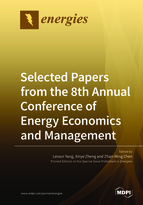Selected Papers from the 8th Annual Conference of Energy Economics and Management
A special issue of Energies (ISSN 1996-1073).
Deadline for manuscript submissions: closed (30 June 2019) | Viewed by 35414
Special Issue Editors
Special Issues, Collections and Topics in MDPI journals
Interests: energy economics; public economics
Interests: energy economics; ecological economics
Special Issues, Collections and Topics in MDPI journals
Special Issue Information
Dear Colleagues,
This Special Issue will consist of selected papers from the 8th Annual Conference of Energy Economics and Management, a large conference held in Beijing, China, 22–24 September 2017. The topic of this conference will be “Energy Transition of China: Opportunities and Challenges”. This conference is co-hosted by the Management Science Department of National Natural Science Foundation of China (NSFC), the Chinese Society of Energy Economics and Management (under SCOPE), and Renmin University of China.
This conference is one of the leading conferences in China for presenting novel and fundamental advances in energy economics and management for policy decision making. The purpose of this conference is for scientists, scholars, engineers, and graduate students from universities and research institutes to present ongoing research activities in order to exchange research ideas in the area of energy economics and management. This conference provides opportunities for delegates to exchange new working papers and application experiences, face-to-face, in order to establish research or collaboration relations. The scope of this Special Issue encompasses topics related to energy economics and management at both the macro- and micro-levels.
For more information about the 8th Annual Conference of Energy Economics and Management please click on: www.cseem.cn.
Prof. Dr. Liexun Yang
Prof. Dr. Xinye Zheng
Prof. Dr. Zhan-Ming Chen
Guest Editors
Manuscript Submission Information
Manuscripts should be submitted online at www.mdpi.com by registering and logging in to this website. Once you are registered, click here to go to the submission form. Manuscripts can be submitted until the deadline. All submissions that pass pre-check are peer-reviewed. Accepted papers will be published continuously in the journal (as soon as accepted) and will be listed together on the special issue website. Research articles, review articles as well as short communications are invited. For planned papers, a title and short abstract (about 100 words) can be sent to the Editorial Office for announcement on this website.
Submitted manuscripts should not have been published previously, nor be under consideration for publication elsewhere (except conference proceedings papers). All manuscripts are thoroughly refereed through a single-blind peer-review process. A guide for authors and other relevant information for submission of manuscripts is available on the Instructions for Authors page. Energies is an international peer-reviewed open access semimonthly journal published by MDPI.
Please visit the Instructions for Authors page before submitting a manuscript. The Article Processing Charge (APC) for publication in this open access journal is 2600 CHF (Swiss Francs). Submitted papers should be well formatted and use good English. Authors may use MDPI's English editing service prior to publication or during author revisions.
Keywords
- energy transition
- reform of energy industry
- energy efficiency and conservation
- energy economics
- climate change economics
- carbon trading market
- low carbon development pathway
- energy finance
- energy trade
- energy security
- policies in new energy industry
- innovation in energy technology
- energy poverty and health
- energy systems modelling
- integrated energy evaluation model
- environmental economics
- green development
- household energy consumption
- low-carbon consumption behavior
- energy management and policy making based on big data







